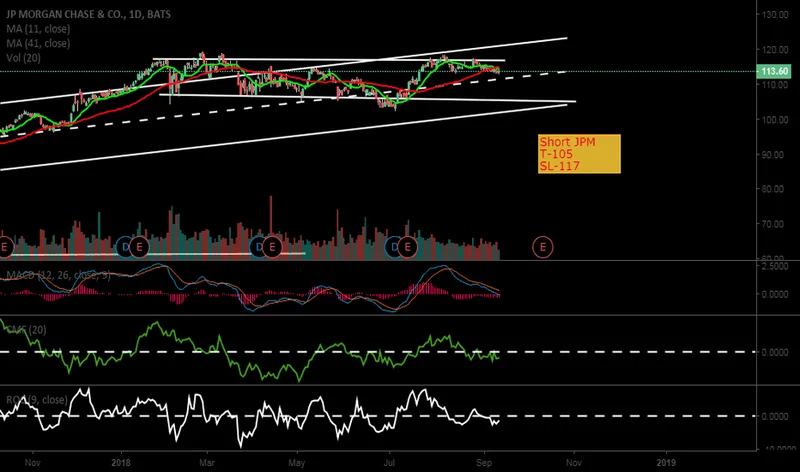On the surface, the numbers from JPMorgan Chase’s third-quarter earnings report looked like a clean, decisive victory. Imagine the pre-market buzz on Tuesday morning, the cool glow of trading screens as the data hit the wires. Diluted earnings per share of $5.07, handily beating the Street’s estimate of $4.85. Revenue of $46.43 billion, a full billion over consensus. These aren’t just beats; they are declarative statements of financial health from America’s largest bank.
Year-over-year, the picture was just as robust. EPS was up a healthy 16.02%, and revenue climbed nearly 9%. The engine behind this growth? A 9% jump in Banking & Wealth Management, fueled by higher net interest income. In a high-rate environment, the bank was doing exactly what a bank is supposed to do: make money on its money. The stock had already rallied 2.35% the day before, seemingly in anticipation of this good news.
And then, the market rendered its verdict. JPM stock ticked down.
The drop was modest, less than half a percent—to be more exact, 0.43% in pre-market trading. But in the world of high-finance, where algorithms parse every syllable of an earnings release, this wasn't just noise. It was a signal. The market saw a blockbuster report and collectively decided it was worth less than it was the day before. The immediate, logical question is: why? The answer, as it so often does, lies not in the spreadsheet, but in the subtext.
The Guidance That Erased the Gains
Every quarterly report has two parts: the story of the last 90 days and the forecast for the next. While the numbers for Q3 2025 were solid, the forward-looking sentiment from Chairman and CEO Jamie Dimon was anything but. His statement was a masterclass in carefully worded caution. "While there have been some signs of a softening, particularly in job growth, the U.S. economy generally remained resilient," he began, before delivering the pivot. "However, there continues to be a heightened degree of uncertainty stemming from complex geopolitical conditions, tariffs and trade uncertainty, elevated asset prices and the risk of sticky inflation."

Let’s deconstruct that. This is the financial equivalent of a ship’s captain announcing a new speed record while simultaneously pointing to a gathering storm on the horizon. The market heard the first part and acknowledged it, but it priced the stock based on the second. I've looked at hundreds of these filings, and this particular juxtaposition of stellar past performance with a litany of future fears is a classic tell. When a CEO of Dimon’s stature—a man whose voice can move markets—spends more time outlining risks than celebrating wins, it's not boilerplate legal disclaimer. It's a warning.
The market’s negative reaction wasn't an irrational spasm. It was a cold, calculated recalibration of risk. The Q3 numbers reflect a reality that is already in the rearview mirror. Dimon’s guidance, however, provides a map to the treacherous road ahead. What specific geopolitical conditions is he most concerned about that aren't already priced in? And how much does his warning reflect a genuine, data-driven fear within JPM versus a prudent attempt to manage future expectations? These are the questions that traders were asking themselves, and the slight dip in the stock is their collective answer: the future is more uncertain than the past was profitable.
A Disconnect Between Performance and Perception
This entire episode, summarized by headlines like JPM Earnings: JPMorgan Chase Stock Slips Despite Q3 Beats, is a perfect illustration of the disconnect between a company’s operational performance and its market valuation. The bank’s performance was, by any objective measure, excellent. The core business (taking deposits and lending, with a substantial investment banking arm) is executing well in the current macroeconomic climate. The growth in net interest income is a direct result of the Federal Reserve's policy, a tailwind JPM has expertly captured.
Yet, the analyst consensus of a "Moderate Buy" with a modest 7.15% potential upside, even before any post-earnings revisions, suggests Wall Street was already tempering its enthusiasm. The institution is a behemoth, a financial utility. It’s not a high-growth tech stock. Its fortunes are inextricably linked to the health of the entire U.S. and global economy. Therefore, Dimon’s commentary isn’t just about JPM; it’s a proxy for the health of the system itself.
Think of it like a beautifully engineered car that has just posted a record lap time. The numbers on the stopwatch are fantastic. But the driver gets out and tells the engineers he's hearing a strange noise in the engine and the weather forecast calls for ice on the track. Do you bet on the last lap time or the driver’s warning? The market chose to listen to the driver. The 0.43% dip wasn't a punishment for a bad quarter; it was the market pricing in a higher probability of a skid on the next turn. It's a subtle but critical distinction.
The Real Story is the Risk Premium
Ultimately, the JPM earnings report wasn't about earnings at all. It was a test of whether the market values past certainty or future uncertainty more. The numbers were a reflection of the bank’s resilience. The stock’s reaction was a reflection of the economy’s fragility. Jamie Dimon provided the qualitative data—the fears of inflation, geopolitical turmoil, and asset bubbles—that completely overshadowed the quantitative data of a record quarter. The market is a forward-looking mechanism, and on this day, it looked past the impressive results and saw the shadows Dimon was pointing to. The slight dip was the price of that fear.









